Abstract
Over the recent years, it has been stated that the number of professional architects in Malaysia is insufficient to cope with the demands of the developing nation. Ratio of architect to population currently stands at around 1:15000, which is a far from UNESCO recommendations of 1:4000 to 1:8000 for developed countries. However, the situation in Malaysia cannot be simply solved by encouraging the nation’s youth to take up careers in architecture. The industry surrounding the architecture profession around the world has undergone changes, particularly due to the evolution of businesses and transition to the online platform. With those changes disrupting global markets, a different strategy is needed in order for future professionals in Malaysia to keep up with global competition and to sustain themselves financially. ‘Archipreneur’ is a term coined to describe a generation of architects who embrace the multidisciplinary approach of design; as a designer and an entrepreneur. While this trend has been picking up in other parts of the world, little have been discussed regarding the topic in Malaysia. This paper presents the results of a survey conducted on a number of registered architects in Malaysia regarding the issue of ‘Archipreneurship’. It was found that 81.3% of the respondents practice architecture in a conventional manner and 78.1% acknowledged that it may be a disadvantage in the current and future market scenarios. 90.6% respondents also admitted being involved in some form of entrepreneurship in order to sustain themselves financially.
Keywords: Archipreneur, architecture, business, entrepreneurship
Introduction
As of 10th June 2019, the number of professional architects registered with the board is 2182 (Board of Architects Malaysia, 2019). According to the Malaysia Productivity Corporation (MPC) (2016), this Figure 1 results in a ratio of 1 professional architect to around 15000 citizens of Malaysia. This is a staggeringly low number compared to the target ratio of 1:4000 to 1:8000 recommended by UNESCO for developed countries. Figure 1 below compares the professional architect to population ratio of Malaysia against selected countries.
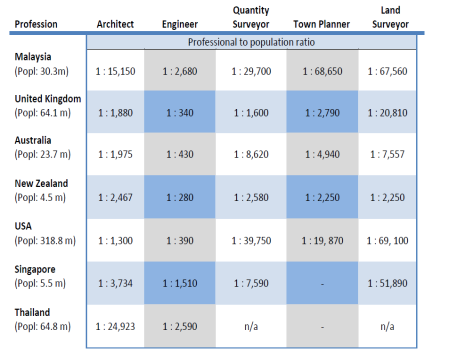
However, solving the problem of shortage in architects it is not as simple as encouraging more people to take up architecture. Instead, the entire approach to the profession may need to change (Christou, 2018). Apart from the lengthy duration of study and industry training required to attain the license, new issues have appeared that may discourage future professionals and challenge those who are already practising; lack of business education in the architecture syllabus, existing architect ethics and codes that hinders business growth and the disruptive 4th industrial revolution (4IR).
The first issue identified is that in architecture education, it is often overlooked that the architecture practice is a form of business; essentially a paid service provided to those who require design work. In fact, the business component – which has been seen as more important than the license itself (Reinholdt, 2015; Hall, 2016) – is barely touched upon in architecture education. As architects, they are trained to innovate and think creatively – to strive to achieve ‘Starchitect’ status (Wong, 2015) – however there is a stumbling block when applying these skills to their business (Archipreneur, 2015; Kilkelly, 2016). To address this, a significant number of universities have already started to change in tune to the concept of archipreneurship; i.e. MIT, with DesignX (Maescher, 2016; Grozdanic, 2017).
Secondly, Malaysia’s Architects Act 1974 (2019) does not generally recognise non-conventional work (such as article writing, graphic design, videography and art) as within the job scope of an architect Additionally, in a report on the Regulatory Review on Price Fixing for Professionals in Building Constructions by the Malaysian Competition Commission and Malaysian Productivity Corporation (2014) it is stated that “Professionals are not businessmen” and “Fees are fixed by the suppliers, not by the forces of supply and demand” (MCC & MPC, 2014). These are clear contradictions to the nature of competitive business in general; which the AIA (American Institute of Architects) has remedied to an extent by reviewing minimum fees regularly (Koger, 2018). The activity of marketing is also tightly controlled by the Architects Rules 1996 and Codes of Conduct (2019). The requirement that architecture marketing should be “superlative, comparative, informative yet not cheapen the image of the profession to be discredited or ridiculed” is seen as confusing and needs to be remedied (Sears, 2018; Kolleeny, 2001).
Another area of challenge is one presented by the 4IR. As businesses shift to online networks and collaborations, architecture practices will soon have to follow suit (Josal, 2017). However, this is only possible with a collaboration between architects and specialists in other fields such as computer software and information technology (Archipreneur, 2015). BIM (Building Information Modelling), coupled with cloud computing is one strategy that could bridge architecture firms worldwide. However, the teaching of BIM in architecture school is insufficient in order for one to become competent enough in the software for immediate use in the industry (Fontan, 2017). Virtual Reality (VR) and Immersive Architecture are other forms of architecture communication brought by the 4IR, enabling long-distance collaborations; in an artificial and non-physical space that you can be observed, navigated and interacted with. The technology utilizes a combination of computer graphics, wireless tracking technology, headsets, high-definition (HD) projectors, and much more; also requiring support from non-architect specialists (TMD Studio, 2018).
Problem Statement
A few factors have been identified in this research as challenges that are currently hindering architects from cultivating prosperous business in Malaysia. This is especially true for younger individuals and smaller firms, which have less resources and freedom to implement drastic changes in short durations. The issues are:
- Lack of education pertaining to business in the college or university syllabus, resulting in lower levels of awareness in starting and managing an architecture practice.
- Existing architect ethics and codes of conduct which are counterproductive in the business world.
- The 4th industrial revolution that is changing the overall nature of businesses worldwide.
Research Questions
Considering the implication that Malaysia still follows the conventional method of architecture education and practice, this research seeks to establish how aware the local professionals are with the concept of archipreneurship. The following questions formed the basis of the study:
- Are architects in Malaysia still practicing and intend to practice the conventional approach to the occupation?
- Are architects in Malaysia aware of the concept of archipreneurship?
- Are architects in Malaysia currently engaged in entrepreneurship or willing to start an entrepreneurship?
- What are the multidiscipline works which architects find most suitable to be taken up in an archipreneurship?
- Do architects in Malaysia view their conventional approach to practice as a disadvantage in the current market environment?
- Do architects in Malaysia view the conventional approach to architecture practice as becoming obsolete in the future?
- Do architects in Malaysia feel that they are out-of-date in the current use of science and technology in architecture practice?
Purpose of the Study
The purpose of this study is to connect with a population of currently registered architects in the Malaysian industry and gain an insight on their awareness, as well as interest in the topic of archipreneurship that is becoming popular globally; especially in developed countries. Below is the outlined purpose of the research that shaped the research method:
- To find the percentage of architects that are and will be practicing the conventional approach to the occupation.
- To find the percentage of architects who are aware of the concept of archipreneurship.
- To find the percentage of architects who are engaged in entrepreneurship or willing to start an entrepreneurship.
- To find the multidiscipline works which are of interest to architects but listed outside of the conventional jobs for their occupation.
- To find the percentage of architects who view the conventional approach to architecture practice as a disadvantage in the current market.
- To find the percentage of architects who view the conventional approach to architecture practice as becoming obsolete in the future.
- To find the percentage of architects who find that they are out-dated in their knowledge of science and technology in architecture practice.
Research Methods
This is a quantitative research, conducted via a survey that was distributed online to 150 architects (with 32 respondents). The duration of the survey was 7 days; from the 22nd to 29th March 2019. The questions in the survey consists of close-ended Yes/No questions that corresponded to the research objectives that establishes population size. Two of the questions were accompanied with additional query; these will provide more information regarding the type of archipreneur work that architects will most likely engage in, as well as give insight as to why or why not a population of architects keep abreast with science and technological advancements.
Findings
The first two questions asked whether architects are still practicing the conventional way as determined by the Board for an architectural practice. A majority 81.3% answered ‘YES’ (Figure 2). The second question of whether they have heard of the term ‘Archipreneur’ was responded with 50% ‘YES’ and 50% said ‘NO’ (Figure 3).
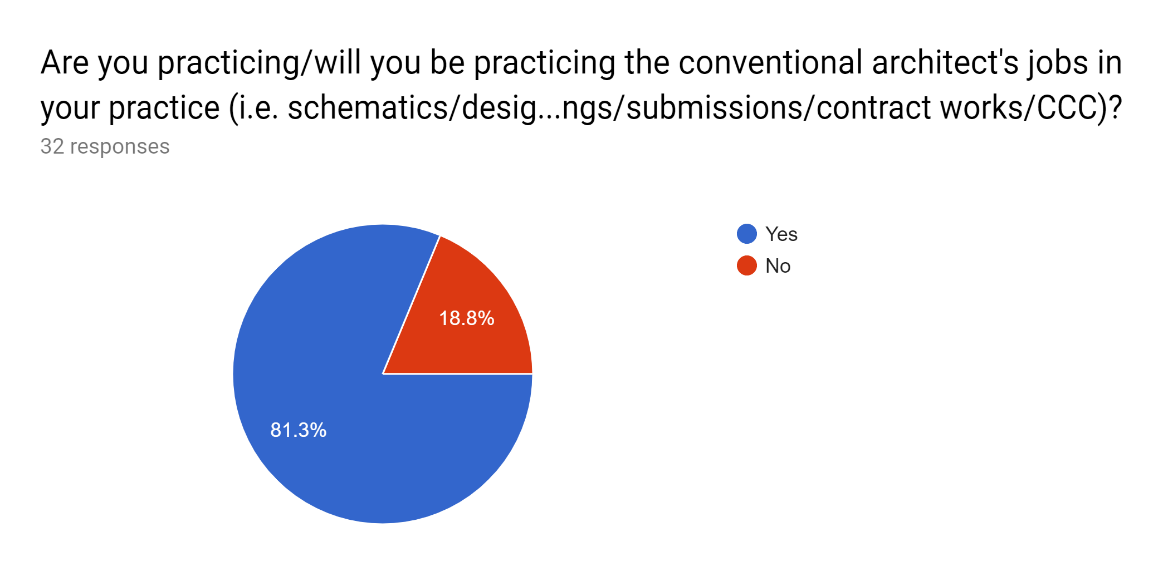

Question 3 – as shown in Figure 4 below – provided an interesting insight, as when asked if the respondents have been practicing entrepreneurship (not archipreneur) 90.6% stated ‘YES’. This could be due to the general population being familiar with the suffix ‘entre’ as opposed to ‘archi’ preneurship. And it appears that most architects do venture in some form of entrepreneurship apart from their conventional architecture practice.
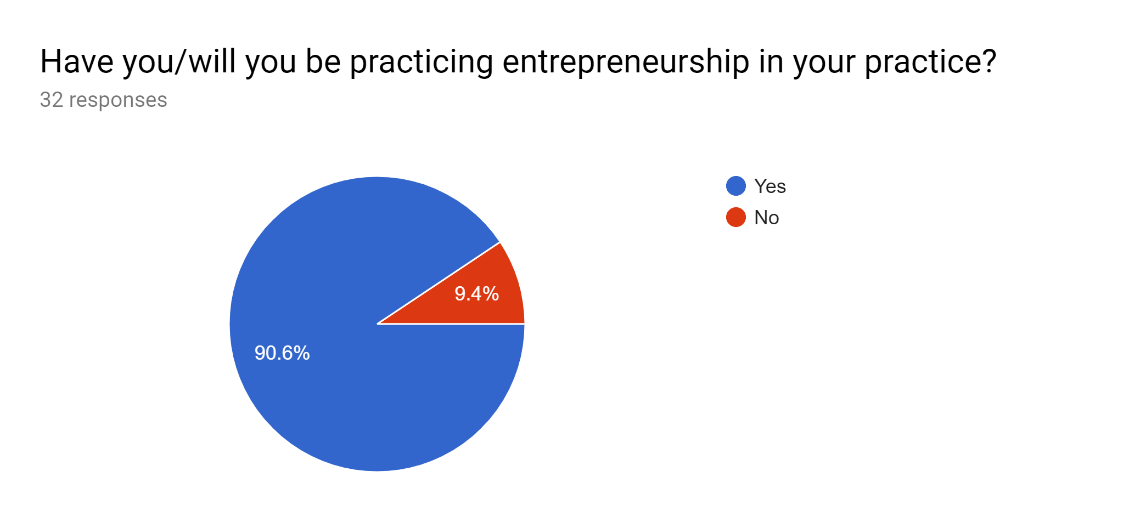
Respondents were then asked to list the types of entrepreneurship jobs viable for architects. The top answers given were; specialist consultant, interior designer, contractor, graphic designer, educator and product designer. The answers that respondents provided also included grab driver, motivator and travel agent. Interestingly, marketer was also found on the list of answers. This shows that the surveyed population of architects in Malaysia are diverse in their interest of entrepreneurship.
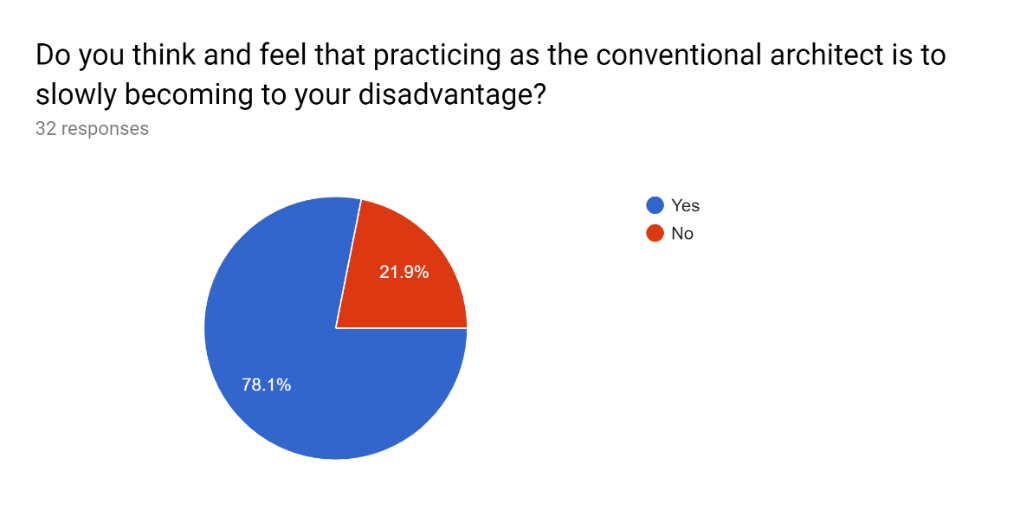
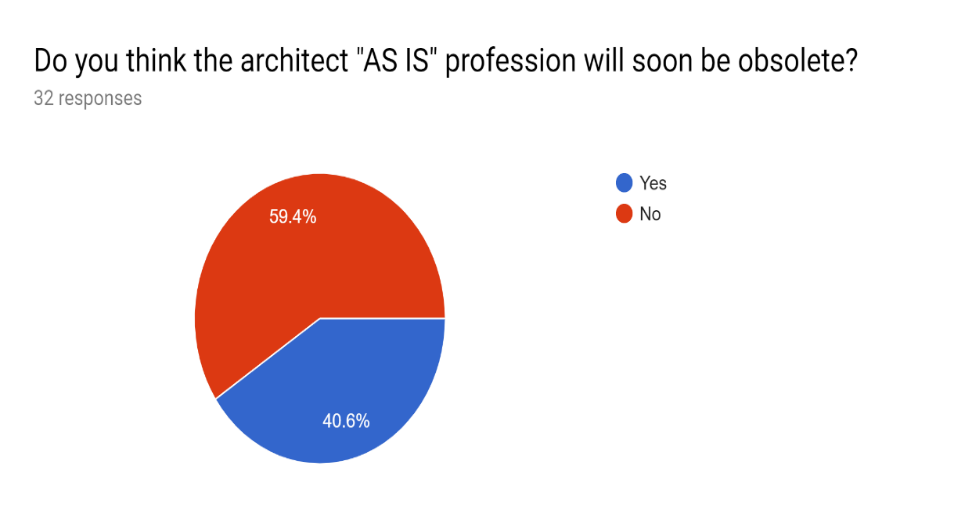
The next question asked respondents if practicing the conventional architecture will be a disadvantage, a majority of 78% stated ‘YES’ (Figure 5). This implies that the conventional approach may not be working effectively anymore, and changes to the practice are needed. However, when asked if the architect ‘AS IS’ profession will become obsolete soon 59% stated ‘NO’; implying that there is still some hope and conventional architects are still needed in the industry (Figure 6).
The last question relates to technology and seeks insight from the respondents about the future; whether architects feel left out with the 4IR in construction. A majority of 62% stated ‘NO’. This implies that this population of architects are keeping pace with evolving technology as it relates to their professions. It also shows awareness that technological skills need to be improved consistently. Having said that, a still significant 38% had stated ‘YES’; with reasons being that they belong to the ‘old school’ generation, that technology is evolving too fast for them to catch up, with them having severe lack of tech skill and that current technology is costly. This is shown in Figure 7 below.
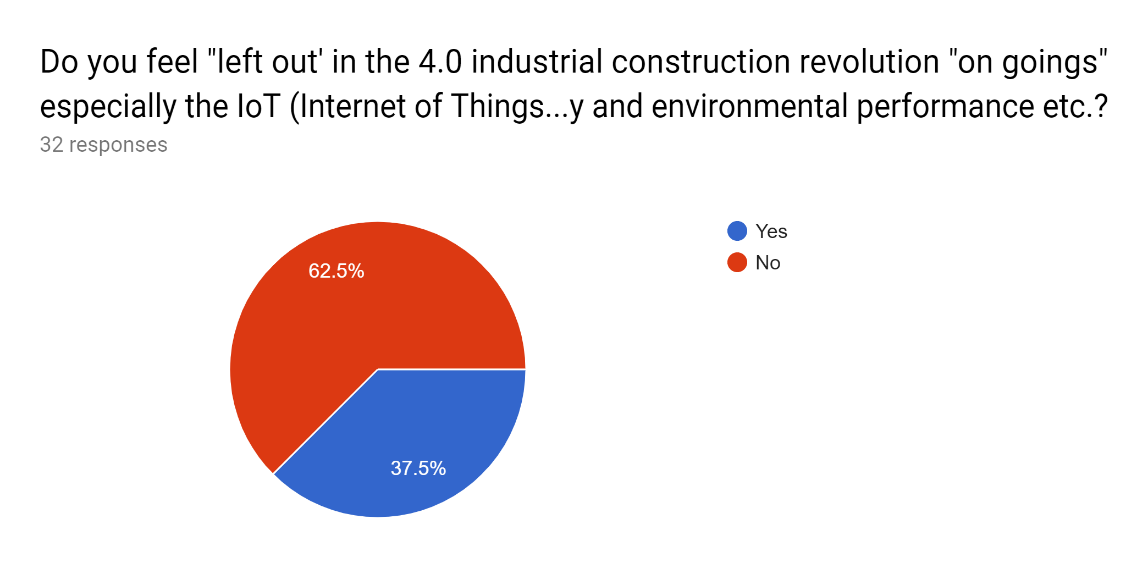
While results from the last question showed that only 38% of the respondent population being ‘left out’ in the technological advancement of digital tools, it is still worth noting that this implies: One out of three architects are using obsolete technology in their practice. In an effort to improve the nation’s standing as a smart and developed country, this issue can be seen as a problem that must be taken seriously.
Discussion
It is clear that the survey conducted was simple, short and was not extensively designed; however, the results achieved managed to provide some insights to the current views of Malaysian architects. Even though most architects are practicing the conventional methods of discipline – many have found that it may be to their disadvantage. The likely reason to this being the current state of the Malaysian economy, resulting in fewer private or small-scaled projects.
Many of the respondent architects admitted being engaged to some sort of entrepreneurial activity and this is crucial during hard times and down turns. However, it is shown that they need to master the skills and attain knowledge to better choose the specific entrepreneurial activity which could help them in their architectural practice. Therefore, there is a need for most architects to turn to archipreneurship. Teaching architecture (education), product design, marketing and conducting freelance design work are all feasible archipreneurial activities. Other suggestions such as becoming a Grab driver or starting a food business may be far off from the norm, but in a world, which is full of uncertainties and filled with challenges, it may still be a viable option.
Conclusion
The structure of architectural practice of the future may resemble a consultancy of collaborative specialists. These specialists (creative, financial, strategic, etc.) come together for projects under a director (who may not be an architect). So, the architect cannot continue to remain traditional in any possible sense.
We may see in the future, more architects and other practitioners working in broad, interdisciplinary projects. They will be in internationally focused, creative and strategic businesses. The architects need to expand the modes of their practices. In fact, it is demanded that they do so and to get into other diverse fields of design and technology.
Marketing is a field not to be forgotten in architectural practice. It is a way a firm can consistently think about its future. Architects cannot abide by stringent outdated rules on advertising and marketing. Architectural practice is a business which depends on its marketing. Architecture, education, communication, business and marketing are all key in the survival of an architect.
A potential direction of this research would be to look into the education syllabus of various architecture programs in Malaysia, as well as any form of entrepreneurship talent incubation.
Acknowledgments
The authors would like express gratitude to the USM R. U. Research Grant (No. 816301) for the funding of this study and to the respective institutions for this collaboration.
References
Archipreneur (2015). Archipreneur insights: 10 interviews with the worlds leading archipreneurs. Berlin: Archipreneur.
Architects Act 1974 (Accessed 1 March 2019). Retrieved from https://people.utm.my/tlchoon/files/2015/09/ARCHITECTS-ACT-1967-ACT-117.pdf
Architects Rules 1996 and Codes of Conduct. (Accessed March 1, 2019). Retrieved from http://www.lam.gov.my/index.php/act-rules/finish/14-act-and-rules/5498-architects-rules-1996.html
Board of Architects Malaysia. (2019). List of registered professional architect. Online. Retrieved from http://portal.lam.gov.my/website_member_list.php?gtype=pa [Accessed June 10, 2019]
Christou, N. (2018). Architects as social entrepreneurs. Arena Journal of Architectural Research, 1-14.
Fontan, E. (2017). Archipreneur I: Effective tool & method. Online. Retrieved from http://www.weareenzyme.com/archipreneur-i-effective-tool-method/ [Accessed June 11, 2019]
Grozdanic, L. (2017). How startup accelerator DesignX turns architecture students into entrepreneurs. Online. Retrieved from https://archipreneur.com/startup-accelerator-designx-turns-architecture-students-entrepreneurs/ [ Accessed March 10, 2019]
Hall, T. (2016). The report: Why some architects and designers don't want to grow their businesses. Online. Retrieved from https://www.architecturaldigest.com/story/why-some-architects-and-designers-dont-want-to-grow-their-businesses [Accessed March 20, 2019]
Josal, L. (2017) The future of the architecture practice. Online. Retrieved from https://www.di.net/articles/future-architecture-practice/. [Accessed March 20, 2019]
Kilkelly, M. (2016). The archipreneur concept: A review. Online. Retrieved from https://archsmarter.com/archipreneur-concept-review/ [Accessed March 1, 2019]
Koger, M. (2018). Calculating the architect’s fee: Is there a better way? Online. Retrieved from https://www.aia.org/articles/202726-calculating-the-architects-fee-is-there-a-b [Accessed March 20, 2019]
Kolleeny, J. (2001). Marketing today: Balancing people and machines. Architectural Record, 189(5), 180-185.
Maescher, T. (2016) The Archipreneur Concept. Berlin: Archipreneur.
Malaysia Productivity Corporation (MPC). (2016). Regulatory review report. Online. Retrieved from http://www.mpc.gov.my/wp-content/uploads/2016/05/Chapter-9.pdf [Accessed June 10, 2019]
Malaysian Competition Commission and Malaysian Productivity Corporation (MCC & MPC). (2014). Report on the regulatory review on price fixing for professionals in building constructions by the Malaysian Competition Commission and Malaysian Productivity Corporation (2014).
Reinholdt, E. (2015). Architect and Entrepreneur: A Field Guide to Building, Branding, and Marketing Your Startup Design Business Kindle Edition. Online. Retrieved from https://www.amazon.com/Architect-Entrepreneur-Building-Branding-Marketing-ebook/dp/B00VXUJV2E [Accessed 20 March 2019]
Sears, E. (2018). Marketing for architects: The authoritative guide (with case studies). Online. Retrieved from https://www.businessofarchitecture.com/marketing-for-architects/ [Accessed 20 March 2019]
TMD Studio. (2018). Emerging trends that will shape the future of architecture. Online. Retrieved from https://medium.com/studiotmd/emerging-trends-that-will-shape-the-future-of-architecture-356ba3e7f910 [Accessed 20 March 2019]
Wong, K. (2015) Starcitect fever – Top 10 cutting edge architects you should know about. Online. Retrieved from https://www.bisnow.com/national/news/other/x-starchitects-51368#0 [Accessed 20 March 2019]
Copyright information

This work is licensed under a Creative Commons Attribution-NonCommercial-NoDerivatives 4.0 International License.
About this article
Publication Date
26 December 2017
Article Doi
eBook ISBN
978-1-80296-950-4
Publisher
Future Academy
Volume
2
Print ISBN (optional)
-
Edition Number
1st Edition
Pages
1-882
Subjects
Technology, smart cities, digital construction, industrial revolution 4.0, wellbeing & social resilience, economic resilience, environmental resilience
Cite this article as:
Fadzil*, S. F. S., Omar, N. A. M., & Aun, W. T. (2017). Archipreneurship: Responses From Architects In Malaysia. In P. A. J. Wahid, P. I. D. A. Aziz Abdul Samad, P. D. S. Sheikh Ahmad, & A. P. D. P. Pujinda (Eds.), Carving The Future Built Environment: Environmental, Economic And Social Resilience, vol 2. European Proceedings of Multidisciplinary Sciences (pp. 856-864). Future Academy. https://doi.org/10.15405/epms.2019.12.87
